3. Observatory Science
While focusing on the Hot and Energetic Universe, the breakthrough capabilities of the X-IFU will enable a wealth of new science investigations to be performed for a wide range of astrophysical sources of great interest to the broader astronomical community.
Solar system and planetary science
Through observations spanning twenty years and returning a wealth of data, the X-ray observatories XMM-Newton and Chandra have led to a golden era of solar system X-ray exploration. They have opened a new window on the phenomena taking place in planetary atmospheres and magnetospheres, and on their response to solar activity.
Observations have raised more questions about the nature and relative roles of the physical processes that may be driving auroral X-ray emissions. Most of these questions can be resolved by NewAthena X-IFU’s observations coupling unparalleled sensitivity with high resolution X-ray spectroscopy. The X-IFU will determine the species, and thus the origin (solar wind or volcanoes on Jupiter satellite’s Io), of the ions responsible for Jupiter’s soft X-ray aurora, and will test theories of ion acceleration in the planet’s magnetosphere. High sensitivity observations of X-rays from the Galilean moons, the largest moons of Jupiter, will allow surface composition measurements. Studies of the Io plasma torus, a region around Jupiter filled with plasma, will shed light on the yet unknown mechanisms energising its X-ray emission. A search for X-ray aurorae on Saturn will reach much greater depth than possible so far. The X-IFU will spectroscopically map Mars’s exosphere through differing solar wind conditions and seasons, as well as the comae, a nebulous layer around the centre of comets transiting in the Sun’s neighbourhood, using them as probes of solar wind conditions.
The X-IFU promises to start the next golden era of solar system X-ray investigations. Some powerful synergies are expected between its remote observations and the in situ measurements that will be carried out in the same timeframe by the JUICE mission, orbiting Jupiter.
Exoplanets
Since the first discovery in 1995 by Major and Queloz, the research for planets orbiting other stars than our Sun has rapidly moved toward the physical characterization of these exoplanets and their atmospheres. From the start, it was clear that X-ray-to-Ultraviolet (XUV) radiations affect exoplanets’ atmosphere, being able to heat and “evaporate” them into space. Since ultraviolet radiation is absorbed by neutral hydrogen on rather short distances, X-rays remain the most effective proxy to learn about the role of these overall XUV radiation on the evolution of exoplanets’ atmospheres.
The X-IFU spectroscopic measurements will drastically improve our knowledge of the XUV radiation’s impact on exoplanets. It is a crucial element in order to understand the effects of atmospheric mass losses and, more generally, of the chemical and physical evolution of planets’ atmospheres especially in the early stages of their evolution. In a few selected planetary systems hosting hot Jupiters (gas giant exoplanets), the X-IFU will allow to search for ingress, eclipse, and egress effects from the transiting planets on the X-ray emission from their host star. In a wider sample of planetary systems, the X-IFU could confirm the evidence of Star-Planet interactions. It is a current open question, whose physical origin is debated. It could be either magnetic or due to evaporated matter falling on the star’s surface. Such interactions will imprint variability features in the X-ray emission. X-IFU may also discover unexpected spectral signatures of planetary atmospheres induced by their host stars high-energy radiation and particle emission.
Massive and low-mass stars
Stars, whatever their mass or age, are able to emit X-rays. This high-energy emission is very sensitive to the details of the physical processes at play in stars and of stellar properties, hence constituting an important probe for these astrophysical objects.
X-rays radiation from massive stars are due to their strong stellar winds, which make them key ingredients for feedback processes within galaxies. However, stellar wind properties are still to be fully understood. Time-resolved high-resolution spectroscopy collected by the X-IFU will provide major breakthroughs in this field. For example, the degree of small-scale wind inhomogeneity in single stars will be probed by examining short-term variations of flux and line shape in a large sample of objects. In addition, Doppler mapping will allow to derive the properties of large-scale wind structures, due to the presence of magnetic confinement, pulsational activity, or co-rotating features – all hinted at in current data, but lacking characterisation. In massive binary systems, where two stellar winds collide, line profile studies will be performed for the first time. Their monitoring over the orbit will provide the immediate post-shock conditions in the wind interaction zone as well as its geometry. This will allow us to test precisely the physical processes at work.
High-energy irradiation of circumstellar disks during star formation and early stellar evolution are crucial for disk evolution and, eventually, for the resulting planetary system formation. By determining its line shapes, short-term variability, and density stratification, the X-IFU will characterize the plasma heated in shocks due to localized impacts of the accreting matter on the stellar surface. In parallel, X-IFU will allow us to investigate the initial phase of the intense stellar flares including mass motions, as well as their influence on circumstellar disks and/or early planetary evolution. Finally, the hot bubbles in planetary nebulae and the hard X-ray emitters at their centre, already detected with the current generation of X-ray telescopes, will be characterized in detail, leading to a better understanding of the material lost in the final stages of low-mass stars’ lives.
Supernova remnants
Supernova remnants (SNRs) are the remains of stellar explosions whose shock wave expands in the interstellar medium for up to tens of thousands of years. This shock wave, initially propagating at around 10000 km/s, will heat the circumstellar medium and the ejected material up to million-degree temperatures. This shock is believed to accelerate most of the Galactic cosmic-rays.
The study of SNRs in the X-ray band provides a unique window to probe the mechanisms of stellar explosions, the nucleosynthesis yield, plasma physics in extreme conditions, and particle acceleration.
The high-resolution spectro-imaging capabilities offered by the X-IFU will allow us to tackle these key questions by mapping the gas temperature, velocity, ionisation state, and abundances along different lines of sights in the remnant. Thanks to Doppler shift measurements, a 3D view of the plasma conditions and ejecta distribution can be reconstructed, which will provide unprecedented 3D observational constraints to compare with numerical simulations of stellar explosions.
Focusing on rare elements (e.g., Chromium and Manganese) with weak emission line, X-IFU will carry out accurate abundance measurements to provide direct insight into the metallicity of the supernova progenitor, and on the single or double degenerate origin in type Ia supernovae. In the case of a core-collapse supernova, these measurements probe the exposure to intense neutrino radiation, a key ingredient in the explosion mechanism.
In the study of shock physics, the plasma in SNRs is usually not in an ionisation and temperature equilibrium. While the ionisation equilibrium has been partially studied with current generation telescopes, the temperature equilibrium can only be studied with a high spectral and spatial resolution telescopes such as X-IFU, near the border of the remnant. Measuring the thermal line broadening directly determines the ion temperature, which allows us to estimate the fraction of kinetic energy injected into particle acceleration.
Discovery science through targets of opportunity
The X-ray sky is dynamic: many sources show extremely strong luminosity variations. The range of such sources covers a large number of objects emitting X-rays, from stellar flares and X-ray binaries in our Galaxy to extragalactic objects such as ultra-luminous X-ray sources, tidal disruption events, or Active Galactic Nuclei.
Many of these time-dependent processes are caused by accretion of matter onto the compact objects that are black holes and neutron stars. Observations of these dynamic phenomena allow us to study the physics of accretion, which next to nuclear fusion is the most important energy producing process in the universe.
In X-ray binaries, for instance neutron stars and black holes which accrete matter from a donor star, changes in the mass accretion rate lead to week- and month-long outbursts. In black hole binaries, these outbursts all follow the same pattern and show different “states” which correspond to different modes of the accretion flow. For example, in recent years it has been found that the accretion disks in black hole X-ray binaries show strong outflows, which are similar to the outflows also seen in some Active Galactic Nuclei. X-IFU observations of absorption and emission lines from the outflow will help to understand its velocity profile and ionisation state, which are important ingredients for models of accretion disk winds. It is not possible to predict when a black hole binary outburst occurs, and when exactly the sources will reach a given state. Therefore, such observations will have to be performed at target of opportunity observations based on multiwavelength monitoring observations of the outburst.
- Associated Mission Design Science Objective (MDSO) : “Equation of State of Neutron Stars”



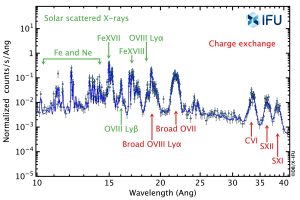
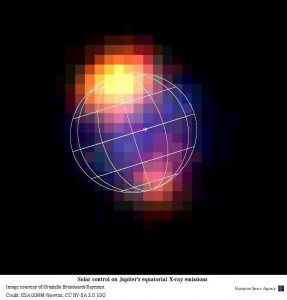


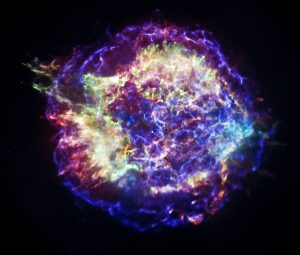
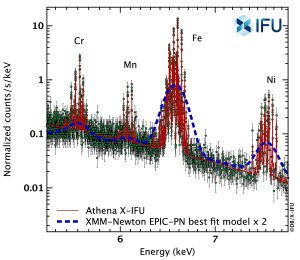
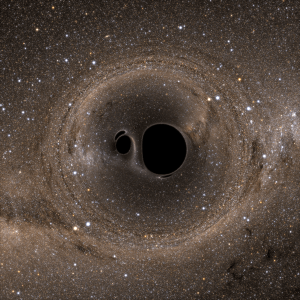
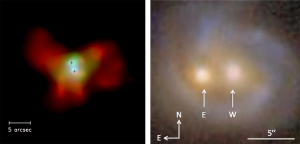
 Youtube
Youtube